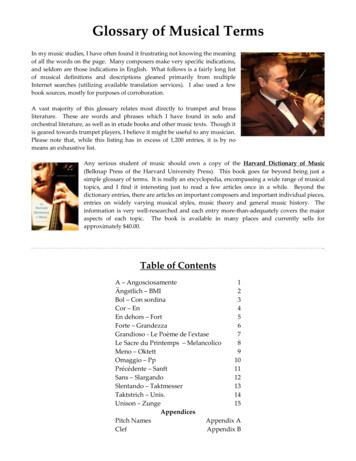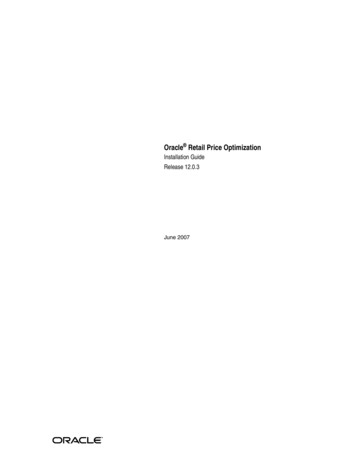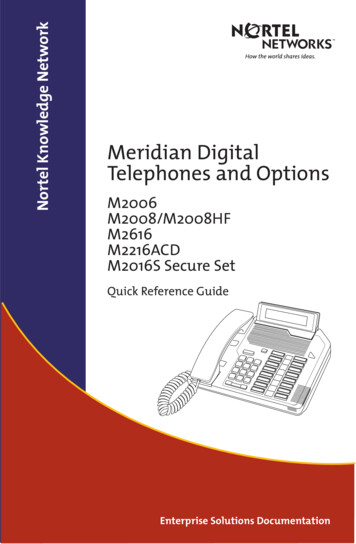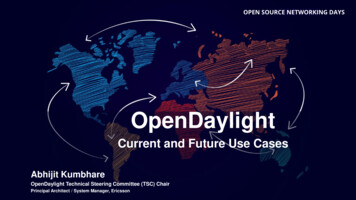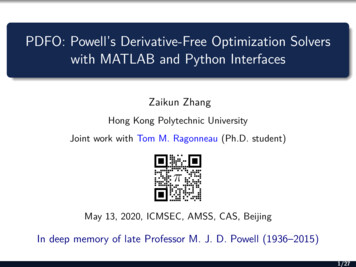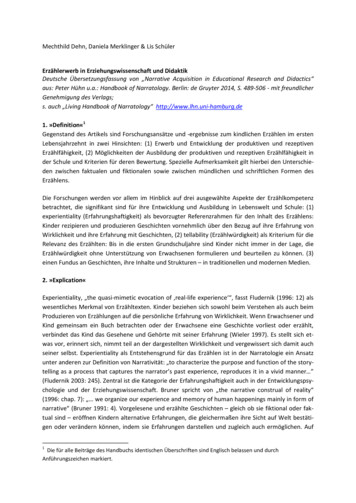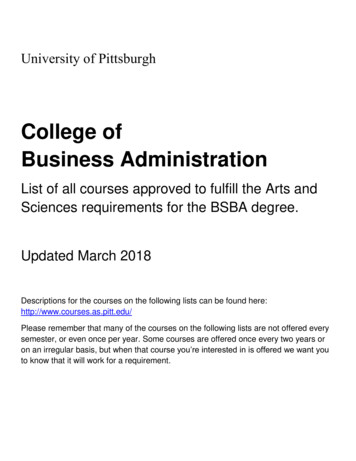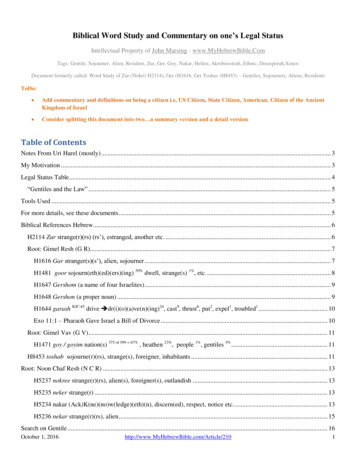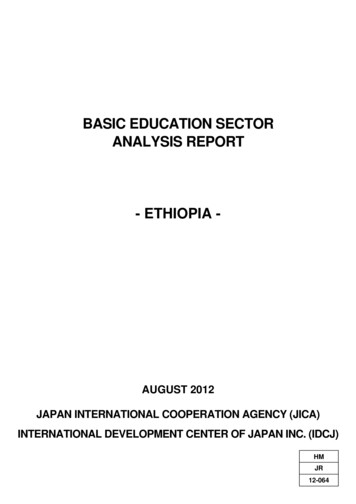
Transcription
Call Center Optimization
Copyright c 2013 Ger KooleAll rights reservedMG books, AmsterdamISBN 978 90 820179 0 8Cover design: Thom van HooijdonkCover photo: Dent d’Hérens and Matterhorn seen from the Tête deValpelline
Call Center OptimizationGer KooleMG booksAmsterdam
PrefaceThis book is written for everybody who is dedicated to improving call center performance. It offers a rational, scientific method to the understandingand optimization of call centers. It explains all generic aspects of call andcontact centers, from the basic Erlang formula to advanced topics such asskill-based routing and multi-channel environments. It does this withoutgoing into technical details, but by showing the outcomes of many calculations. Moreover, there is a companion web site where these calculationscan be executed for different input values. Next to understanding call center phenomena we show how to use these insights to improve call centerperformance in a systematic way. Keywords are data collection, scenarioanalysis, and simulation.This book is a bridge between call center management and those partsof mathematics that are useful for call centers. It shows the manager andconsultant the benefits of an analytical approach, without having to go intothe technical details of it. It also shows the mathematically educated readeran interesting application area of queueing theory and other fields of mathematics. As such, this book can well be used as additional material in anapplied course for mathematics and industrial engineering students. Basicknowledge of call centers is assumed, although a glossary is added in caseof omissions.There are many people who helped me writing this book. I would liketo thank in particular Karin van Eeden, Theo Peek, Roger Rutherford, andArnout Wattel for their suggestions, and Marco Bijvank, Joeri van Hoeve,Auke Pot and Alex Roubos for their help with the online tools. I would alsolike to thank all organizations that allowed me to use their data.I started this project in 2001. It was hard to find time next to my regularobligations, so I found myself writing during holidays and scientific visitsat various locations. At the same time, my understanding of call centersprogressed and I changed several times the way the text is set up. Christi
iiKoole — Call Center Optimizationmas 2012 was the ideal moment to finish. Altogether, it was an extremelyinteresting experience to write this book. I hope that you will find it equallyrewarding to read it.Ger KooleAmsterdam/Amstelveen/Sophia Antipolis/le Croisic/Courdemanges2001–2013
ContentsPrefaceiContentsv1.11458823Introduction1.1 Workforce management1.2 The Erlang C formula . .1.3 Simulation . . . . . . . .1.4 Call center optimization1.5 Further reading . . . . .Performance measures and customer behavior2.1 Call center objectives . . . . . . . . . . . . .2.2 Customer behavior . . . . . . . . . . . . . .2.3 Quality of service . . . . . . . . . . . . . . .2.4 Abandonments . . . . . . . . . . . . . . . .2.5 Occupancy and shrinkage . . . . . . . . . .2.6 Further reading . . . . . . . . . . . . . . . .11111318232526Forecasting3.1 The nature of call arrival processes3.2 The goal of forecasting . . . . . . .3.3 The building blocks . . . . . . . . .3.4 Deseasonalizing . . . . . . . . . . .3.5 Mathematical forecasting methods3.6 Constructing the forecast . . . . . .3.7 Intra-day forecasts . . . . . . . . .3.8 The forecasting process . . . . . . .3.9 Statistical forecast bounds . . . . .27273033353943464850iii.
ivKoole — Call Center Optimization3.103.113.123.1345678Outsourcing contracts . . .Additional information . . .Abandonments and redialsFurther reading . . . . . . .53545455The Erlang system4.1 The Erlang C system . . . . . . .4.2 Multiple intervals and simulation4.3 Simulating general systems . . .4.4 The Erlang X system . . . . . . .4.5 Further reading . . . . . . . . . .575763666873.77777981869090Workforce scheduling5.1 Description of scheduling problems5.2 Shrinkage . . . . . . . . . . . . . . .5.3 Shift scheduling . . . . . . . . . . . .5.4 Agent scheduling . . . . . . . . . . .5.5 Workforce planning . . . . . . . . . .5.6 Further reading . . . . . . . . . . . .Multi-skill environments6.1 The possible gains . . .6.2 Skill-based routing . .6.3 Multi-skill staffing . .6.4 Multi-skill scheduling6.5 Further reading . . . .91919397100102Multi-channel environments7.1 Single-channel staffing . .7.2 Blending . . . . . . . . . .7.3 Multi-channel scheduling7.4 Further reading . . . . . .103103105109112.113113114116120123.Real-time performance management8.1 Schedule adherence . . . . . . . .8.2 Planning with uncertainty . . . .8.3 Flexibility . . . . . . . . . . . . . .8.4 Robust systems . . . . . . . . . .8.5 Manual traffic management . . .
Contents8.69vFurther reading . . . . . . . . . . . . . . . . . . . . . . . . . . . 124Analytics9.1 Business analytics . . . .9.2 Workforce optimization9.3 Workforce analytics . . .9.4 Call center optimization9.5 People . . . . . . . . . .9.6 Further reading . . . . .127127128129132133134Bibliography134A Glossary139B ExcelB.1 International use of Excel . . . . . . . . . . . . . . . . . . . . .B.2 Limitations of Excel . . . . . . . . . . . . . . . . . . . . . . . . .B.3 Further reading . . . . . . . . . . . . . . . . . . . . . . . . . . .145145145146
viKoole — Call Center Optimization
Chapter 1IntroductionThis chapter introduces the ideas and concepts that we will use throughoutthis book. It does so by concentrating on one specific part of call centeroptimization, workforce management (WFM), and more specifically on thedetermination of the number of agents that need to be scheduled to satisfya certain service level. Next to introducing the ideas and concepts, it servesas an introduction to the following chapters in which the different partsof WFM are discussed in full detail. In Chapter 9 call center optimizationoutside of WFM is discussed.There is no need to worry if this chapter raises more questions than itanwers. All questions will (hopefully) be answered in the subsequent chapters.1.1Workforce managementThe activity where analytical techniques are used most often is WFM. WFMis the common name of the planning cycle that results in the schedules ofthe call center agents, usually a few weeks before the period (often a week)for which the schedule is made. As input it uses historic call center dataon traffic loads and information on agent availability; the output consists ofagent schedules.WFM can be split into several more or less separate steps. The first isforecasting the traffic load. This needs to be done at the level of time intervals of usually 15 or 30 minutes. A forecast is easily made, but producingaccurate forecasts is a complicated task that requires considerable skills andknowledge. Good forecasting is crucial for good WFM, following the GIGO1
2Koole — Call Center Optimizationprinciple: if you start the WFM with bad input (”garbage in”), then irrevocably the resulting schedule will be of bad quality (”garbage out”). Whatmakes good forecasting difficult are the many factors that influence arrivingcall volume, and the fact that due to the random nature of the call arrivalprocess one can never be completely sure what the causes were of observedfluctuations.The second step in WFM is determining the required staffing levels foreach interval. Sometimes this is considered to be part of forecasting, but itis at this point in the WFM process that demand and supply are matched:here it is determined how many agents (and possibly which types of agents)are needed at every interval to obtain the required service level. In simplesingle-skill call centers with only inbound calls the so-called Erlang C formula is often used for this. For more complicated operations with multiple skills and other communication channels such as email more advancedtechniques such as simulation have to be used to evaluate staffing levels accurately. Often however rough approximations are used that give unreliableresults. In the next sections we will introduce in more detail simulation andthe Erlang formula.Next we have to turn the staffing levels into agent schedules or rosters.This is the scheduling step. It can be done in two different ways. In thefirst agents specify their preferences beforehand and an advanced algorithmdoes the assignment taking all constraints (as much as possible) into account. The second consists of agents choosing the shift that they prefer onthe basis of some auction system. The latter method is called shift bidding,and works best when the number of different types of shifts is limited.Integrating staffing and schedulingIt often occurs, due to the relative inflexibilty of shifts, that the requirementto satisfy the service levels in each interval leads to considerable overstaffingat certain moments. This happens for example if there is a short spike in callvolume or if all shifts overlap at some moment. The overall service level isthen considerably higher than necessary. This can be avoided by integratingthe staffing and scheduling steps.Unfortunately WFM does not end with making shifts. Things not always go as planned, and adaptations have to be made. Both changes in callvolume and scheduled agents can occur. An important operational task ismonitoring schedule adherence and reacting accordingly. When call volume isdifferent than expected, then also changes have to be made. This activity is
Chapter 1 — Introduction3often called traffic managament, although in many cases it is the traffic that ismonitored but the workforce that is managed. The whole is called real-timeperformance management.Management, planning and schedulingManagement is a very broad term including all aspects of accomplishing organizational goals. WFM, as just described, is a much more narrow activity. Tocite an expert: ”Workforce management is the codeword for forecasting andscheduling software in the contact center industry” [12]. In fact, workforcescheduling would be a much better term instead of WFM: scheduling is aboutassigning tasks to resources, in this case agents. When considering also theother subjects treated in this book then the term planning fits best. For example,setting up a rational data-based long-term policy concerning the hiring andtraining of new agents is clearly planning, but not scheduling.Agent scheduling is a crucial activity in any call center, without agentschedules the call center cannot operate. Without adequate software it is alaborious activity, especially in bigger call centers. This is the main reasonwhy agent scheduling is automized in many centers, and why many software tools exist for this task. The core consists of algorithms supporting thedifferent steps of WFM, but to make it work efficiently many more modulesare necessary: a database filled with historical call volumes, data with agentinformation, connections with many other systems such as the ACD to gettraffic information, and so forth. Next to that, a number of the larger WFMtools are part of software suites that offer other functionality such as emailhandling.The functionality of these WFM tools varies enormously, and so doesthe quality of the proposed solutions. In practice we see that many tools areonly partly used, and that users have their own, often Excel-based solutions,for, for example, forecasting and staffing. When selecting a new WFM toolorganizations usually mostly look only at the functionality, little or not at theway certain methods are implemented. Every WFM tools has the possibilityto forecast call volume, but the quality of the forecasts depends on the tool.Another example is that most WFM tools support multi-skill call centers,but the way in which it is implemented in the scheduling module variesalso from tool to tool, and with that the quality of the resulting schedules.One of the objectives of this book is to develop a more critical look at WFMand thereby help the reader make better use of WFM tools.
41.2Koole — Call Center OptimizationThe Erlang C formulaIn this section and the following ones we consider the staffing of a singleskill inbound call center. We are interested in computing the optimal staffinglevel, let’s say defined as the minimal number of agents required to answer80% of the calls within 20 seconds. To do so we have to be able to predictthe service level (SL) for a fixed number of agents, and then by varyingthe number of agents we can find the right staffing level. Our predictionof the service level will evidently depend on a number of variables: theforecast (FC) of the call volume, the number of agents, and also the averagecall handling time (AHT). Probably we are interested in staffing levels for awhole day or longer, but because forecasts and therefore also staffing levelsvary over the day we concentrate on an interval of 15 or 30 minutes.The FC is usually given per interval. To have everything in the same unitwe divide by the length of the interval to get the FC per minute. Let us usethe greek letter λ for this number (following a perhaps seemingly strangemathematical habit). Similarly, we denote by β the AHT, also in minutes.Then λ β is called the offered load. This is equal to the number of agentsneeded to be able to handle all incoming calls. However, calls arrive at random moments, and therefore somewhat clustered, and handling times vary.Thus, if you have no or hardly any overstaffing with respect to the offeredload, then the service level will suffer from these short random periods ofhigh load. It is the Erlang C formula that gives the relation between FC,AHT, number of agents and service level, taking the randomness into account. The bad news is that this is not a simple relation that anybody canlearn. The good news is that the Erlang formula has already been implemented in different spreadsheet add-ins, WFM solutions and other tools.Example Consider a call center with a FC of 100 for the 10:00-10:15 interval.The AHT is 3:30. Then λ 100/15 6.66 and β 3.5. The load is thus6.66 3.5 23.33, and the minimum number of agents required to handle all callsis 24. The Erlang C formula predicts that in that situation only around 21% of allcalls wait less than 20 seconds before getting connected. By increasing one by onethe number of agents we find that 28 agents are needed to have a SL of at least 80%.In Chapter 4 we will study the Erlang C formula in more detail. However, there are also certain disadvantages to using the Erlang formula. Thereason is that for the Erlang C calculation reality has been simplified. Certain statistical assumptions are made and certain features of call centers areleft out. Without these assumptions and simplications it is not possible to
Chapter 1 — Introduction5Do it yourselfThere are several Erlang C calculators that can be found on the web.There is also one that is especially designed to accompany this book atwww.gerkoole.com/CCO. You can go there and try to reproduce the numbersof the example. We will make extensive use of this and other tools in this book.compute the formula, but they can lead to considerable discreprencies between prediction and reality. For example, an important feauture that is notpart of the Erlang C model is that some calls, while waiting for service inqueue, abandon. In situations where little calls abandon this is not necessarily a problem, but especially in underload situations this might result in bigprediction errors. Under certain statistical assumptions the model includingabandonments, called the Erlang X model, can be solved (see Chapter 4).Next we consider a different feature of the Erlang formula that can leadto considerable errors. To understand this, we should realize that the performance of call centers is not completely predictable. For example, considerthe handling times. We know the average handling time (AHT) and probably some other statistical properties. However, we do not know the exactduration of the call that is to arrive next. That means that any two intervals,even if all parameters such as the FC and number of agents are equal, willhave a different performance. This has important consequences for call center management: we always have to deal with unpredictable fluctuations.It also means that we have to take into account the unpredictability whenmaking service level predictions. However, the Erlang C formula gives asoutput a single number, and no indication of the size of the error. This is because the Erlang C fomula gives the performance as if the call center wouldrun with the same parameters for a very long time. In reality this is not thecase, usually we consider 15 or 30 minute intervals at a time. For this reasonwe should expect variability in the SL. A method that allows to quantify theSL variability, and also many other features, is simulation.1.3SimulationThe central idea of computer simulation is that we mimic reality in the computer. That is, we generate, on the basis of the forecast, arrival moments.These calls are assigned to virtual agents, or queued if no agents are available. Agents finish serving when the handling times are over, and they startwith a new call or become idle, depending on the situation. Possible other
6Koole — Call Center Optimizationfeatures include calls abandoning. Time progesses as events happen untilthe simulation time is over. All the while, statistics are assembled, for example on the number of calls that are answered within 20 seconds. Finally therequired performance measures are calculated.Because of the unpredictability, any two runs of the simulation are different, even when all input values are the same. In fact, if we take for exampleSL, any outcome is always possible. In a highly understaffed call center itmight be that all calls need incidentally very little time leading to a high SL;conversely, in a well-dimensioned call center, it might occur that the firstcalls have very long handling times leading to congestion and a low SL.However, these situations are less likely to occur. Thus, when repeating thesimulation often enough, we will see that the outcomes are concentratedaround a certain level, apart from a number of outliers. This level is closeto the level that is predicted by the Erlang model. In Figure 1.1 we plotteda histogram of 100 runs for the system of Example 1.2 with 28 agents. Notethat the Erlang C formula predicts a SL of 83%, which falls within the 8085% interval with the highest number of occurences, 34. (In Chapter 4 wewill sharpen our understanding and see that the long run times, 8 hours, iscrucial for this result.)Figure 1.1: SL histogram for 100 runs of 8 hoursThe calculations of Figure 1.1 were based on the Erlang C system. Using simulation it is easy to extend the model with features such as abandonments, different statistical assumptions underlying the handling times,different agents working at different speeds, redials, and so forth. When
Chapter 1 — Introduction7extending to systems with different skills with skill-based routing (SBR),simulation really becomes essential. No equivalent for the Erlang formulaexists in this situation, and except for some unreliable estimations simulation is the only method that can be used, both for staffing decisions (in whichwe vary the number and skills of the agents) and determining the best callrouting parameters. Please note that the last activity is not part of the WFMcycle but can clearly be approached by similar techniques. SBR is discussedin Chapter 6.Simulation can be used instead of the Erlang formula to obtain staffinglevels, which can be used to determine the agent schedules in the scheduling step. Certain tools use an integrated procedure where new solutions areevaluated using simulation, on the basis of which again new solutions areselected, etc. The question remains how to deal with the fact that every simulation run will give a different result. In fact, the question to be answeredfirst is how to deal with the fact that performance in reality will vary fromday to day, even if the parameters remain the same. Does this mean thatperformance prediction is useless, because the outcomes will be differentanyway?Of course, performance prediction is useful, because the outcomes areoften close to the prediction (in a statistical sense, which will be precised).Thus, to avoid having to change too much during the day, it is reasonable tobase the schedule on some form of average performance. This is the type ofaverage which is calculated by the Erlang C formula and which can also beobtained by simulation, by averaging over many runs. Unfortunately, theprecision of simulation outcomes increases slowly with the number of runs,revealing the main problem of simulation: to obtain a high precision for theprediction run times can become very long. This is a big difference with formulas such as the Erlang C, which produce answers within split seconds.Especially in situations where interactively the best solution is sought simulation can lead to very long execution times, to low quality solutions, or toboth. Highly skilled mathematicians and software engineers are needed todesign and build WFM systems that use this method. But, even if a highlyreliable estimate is obtained, we should never forget that real-time performance management will always be necessary, to deal with random fluctuations and other more or less unpredictable events such as agent absence andforecasting errors.
8Koole — Call Center OptimizationIntegrating scheduling and real-time performance managementIn theory, the best thing to do would be to integrate the schedule and the realtime performance management steps as well. Then exactly the right amount offlexibility is scheduled, and over or understaffing with respect to the averagestaffing levels will be chosen optimally. At several research centers around theworld scientist are developing these methods.1.4Call center optimizationOptimizing a call center is more than doing WFM the best possible way.There are many decisions that can benefit from a rational data-driven optimization approach. Some of these concern repetitive operational problemssuch as WFM, others are of a more ad hoc nature. The former are thereforeexecuted by dedicated people that count these activities as (one of) theirmain tasks, the latter require specialists who can apply their analytical skillsto many different problems.A first class of problems are those the enable good WFM. A good longterm hiring policy, skill-based routing, and the right mix of employee contract types is essential for good WFM. In outsourcing contracts the paymentsdepend on the actual traffic, but often also on the difference between theforecast and the actual traffic. Thus knowledge of forecasting, and of forecasting errors, is crucial to call centers who outsource (part of) their traffic.All these issues will be discussed in the relevant chapters related to WFM.WFM is sometimes criticized that it focuses only on efficiency, not onquality. The promise of workforce optimization (WFO) is to remedy this problem. WFO refers to software suites that include, next to WFM, modules forquality monitoring and call recording, (agent) performance management,and eLearning. We discuss the analytics of these activities in Chapter 9.There are many activities that can be thought of that are not yet part ofcall center software, but that would give a company a competitive advantage when addressing. Optimizing a call center means seizing also theseopportunities. All activities together is what we call call center optimization.1.5Further readingReynolds [25] is an excellent introduction to WFM. Cleveland & Mayben[10] is less of an overview, but easier to read, and it contains many interest-
Chapter 1 — Introduction9ing insights.For a list with the major WFM tools see Rosenberg [27].The book [8] contains the historical background of Erlang’s work.Gans et al. [16] and Akşin et al. [2] are overviews giving the state of theart concerning mathematical models relevant to call center management.Both are written for academics, and assume solid mathematical knowledge.Stolletz [34] is also more mathematical.
10Koole — Call Center Optimization
Chapter 2Performance measures andcustomer behaviorThis chapter starts by defining the goals of customer contact and the wayit is linked to customer behavior. Then we consider call center data. Wediscuss how to derive useful performance indicators from the data, considering both quality of service and efficiency. The outcomes of this chapterwill serve as objectives and input parameters of the chapters on WFM andas a basis for the treatment of call center optimization in general in Chapter 9.2.1Call center objectivesProducts are characterized by quality and price. The quality of a productmight have many different aspects. In a production environment wheretangible products are made, many aspects are related to what we might callthe product itself. When we consider a TV set, this could be the size of thescreen, the quality of the sound, and so forth. But there are also aspects thatare not directly related to the product itself, such as the delivery conditionsand the shopping experience (for example, whether it is bought online orin a shop). With customer contact a similar situation exists: certain aspectsare related to the contact itself, certain are related to the way it is delivered.Examples of the former are the quality of the answer and the politeness ofthe call center agent, an example of the latter is the time that a customer hasto wait before being connected to an agent.With customer contact it rarely occurs that callers pay directly for the11
12Koole — Call Center Optimizationcall. An example of an exception is a directory service. Instead, call centers are mainly used to support certain business functions such as sales orproduct support. Then the customer pays indirectly for the call center whenbuying the product for which sales or service calls are done. In the case ofoutsourcing, calls directly generate the revenue, but it is not the caller whopays. Whatever the situation, high call center costs will translate, directlyor indirectly, into a high price for the product concerned. Controlling costsis therefore essential. Whatever the revenue model is for the call center, thebigger part of its costs are personnel costs. They usually account for around70% of the total costs.To be able to improve the quality of a product and/or reduce its costs,we have to able to measure the quality and the costs. To do so we use performance indicators (PIs). These PIs are used in two ways: internally in thecall center, that is, as input to our analytical techniques, and to communicate with stake holders outside of the call center. We have three types of PIs:those that are related to the costs of customer contact, those that are relatedto the quality of the contact, and those that are related to the way customercontact is delivered. For the latter often service level agreements (SLAs) areused.Service level is an ambiguous term, especially in call centers. In its general sense it refers the quality of a product, especially to the non-productrelated properties such as waiting time. An example of a service level agreement is that the abandonment rate should not exceed 5%, 80% of the callsshould be answered within 20 seconds, and the FCR rate should be at least90%. To meet or exceed these objectives a certain budget is made availablein case it concerns an internal call center. In case of an outsourcer the revenue depends on the extend to which the SLA is met. Usually a penalty isapplied when the service level is lower than agreed upon.The aspects of a product by which its quality is defined should also bechosen such that they can be measured. Some aspects are relatively easyto measure, such as the waiting time of a call. Some are harder to measure, such as the friendliness of the agent or the First Call Resolution (FCR)rate. Sometimes they require laborious data analysis or the use of advancedanalytical tools, as can be the case for the FCR rate. In other situations customer surveys are needed, for example by automatically asking part of thecustomers for their opinion about the friendliness of the agent.Costs can also be measured in PIs. One could think that total costs arethe only relevant factor, but this not account for factors that influence the
Chapter 2 — Performance measures and customer behavior13Adverse effects of steering on PIsIt is good that performance is measured using PIs, but they should not becomea goal by themselves. In that case they can even deteriorate quality of service.For example, if agents are stimulated for having short handling times, thenthey might be tempted to interrupt conversations before they are ended. Incertain call centers it happens that agents are financially rewarded for, essentially, cutting calls after
2 Koole — Call Center Optimization principle: if you start the WFM with bad input ("garbage in"), then irre-vocably the resulting schedule will be of bad quality ("garbage out"). What makes good forecasting difficult are the many factors that influence arriving call volume, and the fact that due to the random nature of the call arrival
